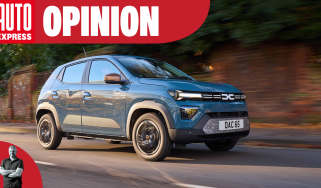Tyre tread depths explained: the legal limit and what it means for you
Bald tyres aren’t only dangerous but they’re also illegal. Here’s everything you need to know about tyre treads

Making sure your car’s tyres have enough tread depth is one of the simplest and most important DIY car checks you can carry out. It can save you money through reduced wear and improved fuel economy, and it can save your life in an emergency situation. Read on for our guide to tyre tread depth.
What is tyre tread depth?
Tyre tread depth is the difference in height between the main surface of the tyre and the raised blocks that make up the tread pattern. The minimum legal tread depth in the UK is 1.6mm, so the raised blocks must sit at least this height proud of the base rubber of the tyre.
Sufficient tread depth is needed to allow water, snow, and grit to disperse through the gaps between the treads as the tyre passes over the road surface. As a tyre wears down, its ability to do this is reduced, so it’s good practice to replace tyres when they reach 3mm of wear rather than waiting for them to go down to the legal minimum.
Different tyres have different tread patterns, but they must all meet the same legal requirements of at least 1.6mm of tread depth across three quarters of the tyre’s width.
How do you check tyre tread depth?
You should pay close attention to your tyre tread depth. The law requires a minimum tread depth of 1.6mm in a continuous band around the central three quarters of the tyre. You can check the tyre’s tread depth with a tyre tread depth gauge, but for a quick visual check, manufacturers often mould little bars into the tread at a height of 1.6mm. You can see or feel if these are flush with the tread – if they are, it’s time for new tyres.
The 20p test
If you don’t have a tyre depth gauge and are unsure about the amount of tread remaining, you can quickly check them with a 20p coin. Simply place the 20p in the main tread grooves of your tyre – if the outer band of the 20p piece is obscured, then your tyre is above the legal limit.
If the outer band of the coin is visible, your tyre may be illegal and should be checked by a garage. Remember to check at three different spots around the tyre to check for even wear.
When should you change tyres?
The law states a tyre should not have less than 1.6mm of tread depth across three quarters of its with. However, it’s a very good idea to replace tyres before they reach that point. It means you don’t risk breaking the law, but tyre performance is maintained as tyres lose a lot of their ability to disperse water and provide the best braking when they drop below 3mm tread depth. A tyre with 1.6mm tread depth can take 50% longer to stop on a wet road than one with 3mm of tread depth.
It's also a good idea to replace tyres in pairs, so if you need to change the front left tyre it’s a wise idea to replace the front right one at the same time. This applies unless you know the other tyre has plenty of tread and is in good condition – just make sure the replacement is the same make and type of tyre as it’s safest to use the same tyres on each axle. And don’t mix summer and winter tyres on the same axle as it will affect the car’s braking, steering, and handling.
What about tyre condition?
Checking your tyre’s tread depth and general condition is vital routine maintenance. Giving them a visual inspection will allow you to look for any nails or sharp objects which may have punctured and become stuck in the tread or sidewalls.
Keep an eye out for any odd-shaped bulges, cuts or cracks as these can weaken the tyre and result in a tyre blow out without warning and potentially losing control of the car. If you do spot anything, get it inspected by a professional mechanic or tyre fitting centre.
Frequently Asked Questions
In the UK, the law says a tyre must have at least 1.6mm of tread depth across three quarters of its width. However, if a tyre is worn below this depth on any part of its tread, it’s best to change the tyre as its performance will be compromised.
A tyre might have the minimum 1.6mm tread depth on three quarters of its width but be worn dangerously on the edge. This could cause poor braking, a sudden blow-out, or land you with a fine and penalty points.
Check out our in-depth test on the best all season tyres or best winter tyres...
Find a car with the experts








